
Bring a slice of the tropics to your home by landscaping with palm trees. These magnificent, tall, leafy plants can turn your front yard into a masterful paradise filled with cooling shade, striking focal points, and comforting privacy.
Tall palms, short palms, thick palms, leafy palms, there are several to choose from, and plenty to fit into your existing landscape. Frame your pool’s entryway with attractive pindo palms, for example, or grow a pygmy date palm on your porch (in a container, of course).
We’ve gathered 15 ideas for landscaping with palm trees to help you create an eye-catching front yard, backyard oasis, and sparkling poolside.
Before we get started, let’s go over a few palm tree basics:
Landscaping With Palm Trees: The Basics
Palms aren’t actually trees
Palms are flowering grass-like plants called monocots. But don’t let this make your head spin –– take these fun facts to your next trivia night instead.
Pinnate vs. palmate
When shopping for your favorite palm tree, you’ll hear the words “pinnate” and “palmate.” What do they mean? Pinnate and palmate refer to the palm’s leaves, also known as fronds. Each adds a different texture and shape to your landscape.
Palmate fronds are fan-shaped. They have leaflets growing from a single shared point at the leaf’s base. These leaves resemble a fan or the palm of a hand.
Pinnate fronds look like feathers, with each leaf growing leaflets on each side of its stem.
Palm tree maintenance
Maintenance needs and drought-tolerance levels vary among the approximately 2,600 species of palms. Sun and shade needs also vary. Winter care also differs depending on the plant hardiness zone you live in and how cold-hardy the palm species is.
When choosing palm trees for your landscape, consider the amount of maintenance they’ll need.
Do you have the time and energy for a high-maintenance palm? If you don’t and can’t afford to hire a tree-care professional, choose a palm tree that doesn’t require much watering, fertilizing, trimming, or disease prevention.
Palms vs. cycads
Palms and cycads share many features, including a similar trunk, leaves, and overall structure. Cycads are commonly mistaken for palms.
Yet these two plants aren’t related.
Another factor that contributes to the confusion between these two plants is similar naming. The sago palm, while often referred to as a small palm tree, is really a cycad. We recommend sago palms in many landscaping designs, including the ideas mentioned below.
15 Ideas for Landscaping With Palm Trees
1. Try new colors
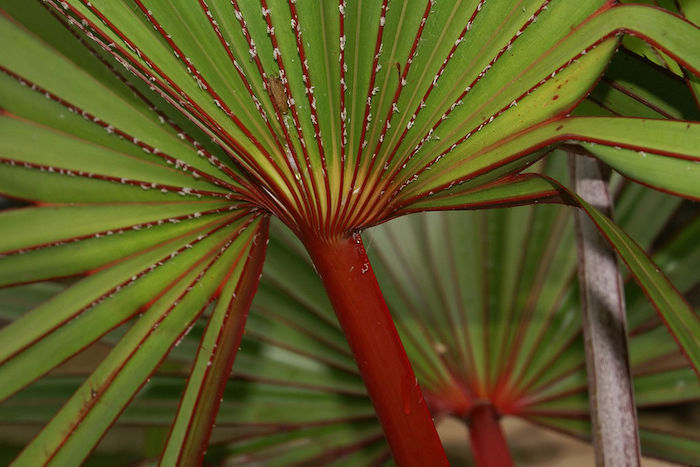
Photo Credit: B.navez / CC BY-SA 3.0
When you’re landscaping with palm trees, it needn’t be all green. But if you’re looking for a monochromatic landscape, by all means, buy more green with your green!
If your lawn needs a new tinge or you want to grow a one-of-a-kind palm tree to impress the neighbors, consider varying colors.
Red Latin palm (Latania lontaroides) is famous for its bright red leafstalks. Mexican blue palm (Brahea armata) grows magnificent blueish-grey leaves. Both plants will stand out in the landscape.
2. Landscape for privacy

When you’re hosting an outdoor barbecue or cookout, palm trees make excellent landscape barriers with thick trunks and broad palm leaves. You won’t have to worry about any wandering eyes when you’re sunbathing.
Plant palms next to one another, and you’ll have a protective wall that helps keep out intruders, absorb noise, block out judging stares, and keep children inside the perimeter.
Areca palms (Dypsis lutescens) make excellent privacy barriers with textured fronds growing densely together. Their stems can grow up to 30-feet tall, making them a spectacular wall of fluffy, arching leaves.
3. Accentuate with a row of palm trees

For a lawn that catches the eye, plant your palm trees in a flattering row that highlights your favorite landscape features.
Want to make friends and family gasp at the new swimming pool, or stress a dramatic outdoor stairway? Line it with tall, single-trunk palm trees with leaves crowned on top of the trunk.
You have a few options when it comes to single-trunked palm trees to highlight your pool, stairs, or driveway:
- Canary Island date palms (Phoenix canariensis)
- Alexander palms (Archontophoenix alexandrae)
- Foxtail palms (Wodyetia bifurcata)
Pro tip: Avoid palms that may steal attention from the main attraction. Areca palms, with their dense leaves and multiple stems, may be a distraction.
4. Shade the pool

When you’re cooling off with a dip in the pool, you don’t want to sweat the moment you hop out. Sprinkle in a few palm trees around the poolscape, and the added shade will keep out the unbearable heat. Your swim will feel extra refreshing, and the sun-kissed patio won’t burn your feet.
Pindo palms (Butia odorata, also known as jelly palm) and pygmy date palms (Phoenix roebelenii) are excellent shade providers. Set up your lounge chairs underneath these leafy palm trees, grab an ice-cold cocktail, and enjoy your backyard paradise.
5. Highlight the flower beds
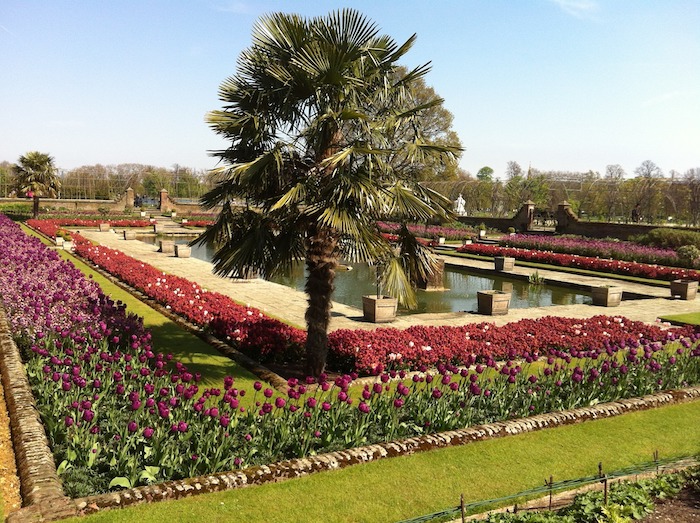
Palm trees don’t always need to scream tropics. They can make an attractive addition to your native flower beds and turn your flowers into the spectacle they’re yearning to be.
If you already have a palm tree in the yard but have no flower beds, you can always add the bloomers. You can design a flower bed around your palm with several style choices, such as color, edging, mulch, flower height, and texture.
While a new palm can attract attention to your forgotten flower beds, a new flower bed also can draw attention to your once lonely palm.
6. Partner with boxwoods
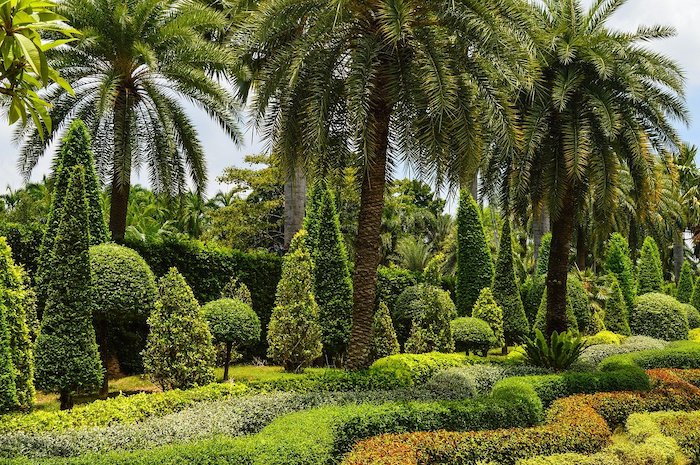
For a stunning blast of texture, combine your palm tree paradise with boxwoods.
This creative landscape design will add lovely shades of green to your yard, as well as shapes, sizes, and eye-catching angles.
Hire a landscape professional to cut your boxwoods into an artistic masterpiece, and you’ll enjoy wandering through your green wonderland.
7. Create a garden centerpiece
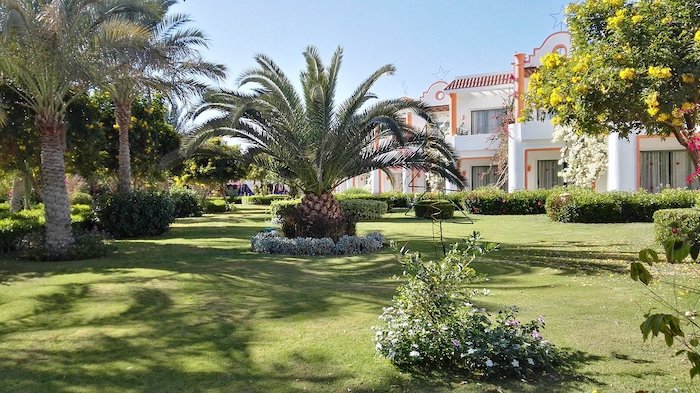
Palm trees make excellent centerpieces in the yard to bring a unified look to the landscape. Low-growing palm trees are typically best, as their foliage will be at eye level (otherwise, you’ll be staring at a tall trunk!).
With long feathery leaves dramatically arching toward the ground, Pindo palms (Butia odorata) make a head-turning focal point.
Sago palms (Cycas revoluta) are also low growing, reaching at most 10 to 15 feet. Their swollen trunks make this cycad a sturdy centerpiece exhibiting beautiful, dark green leaves 2 to 5 feet long.
8. Glow up with landscape lighting

Why stop showing off your landscape when the sun goes down?
A few lights around your palms will dazzle your dinner and party guests. Imagine an evening with friends gathered by the pool with the stars twinkling, and the landscape lights shining across your beautiful palms. The night doesn’t get more perfect than that.
9. Add some cactus
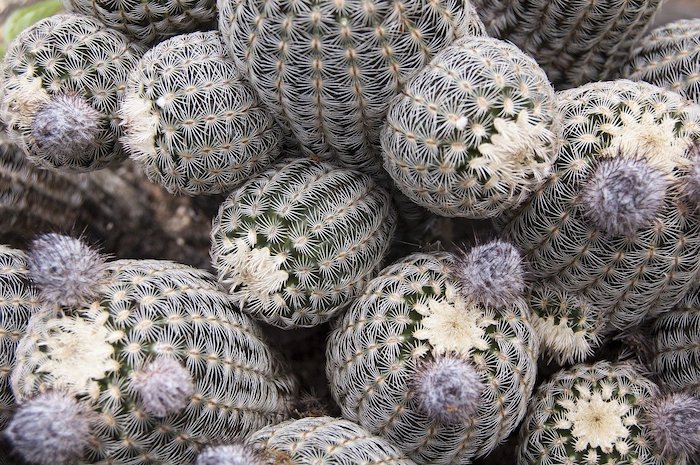
Cactuses can make a wonderful low-maintenance, drought-resistant garden to have around the palm trees. These diverse succulents exist in many different climates around the world, including dry deserts, humid jungles, and high mountains.
Growing these exotic plants with your tropical palm will turn your landscape into a real island getaway.
10. Complete a rock garden
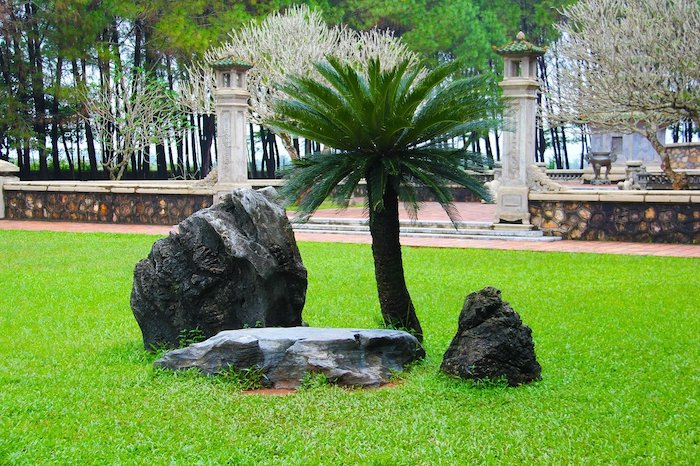
Your calming rock garden has serenity, it has your favorite stones, and a comfy place to sit. But what’s missing? A little shade, maybe a little green, or perhaps a soothing centerpiece is what your rock garden needs. Why not a palm tree?
Rock gardens are popular for their low-maintenance and drought-resistant plants, so you likely will want to opt for a drought-tolerant palm that won’t need much watering.
Date palm (Phoenix dactylifera) is drought-tolerant, has a sturdy trunk, and features feathered fronds. The top of this palm features a crown of arching pinnate fronds up to 20 feet in length with approximately 100 leaflets on each frond.
Your rock garden will become the perfect place for quiet reflection and meditation as you welcome the shade under the palm leaves.
11. Cool off on the balcony
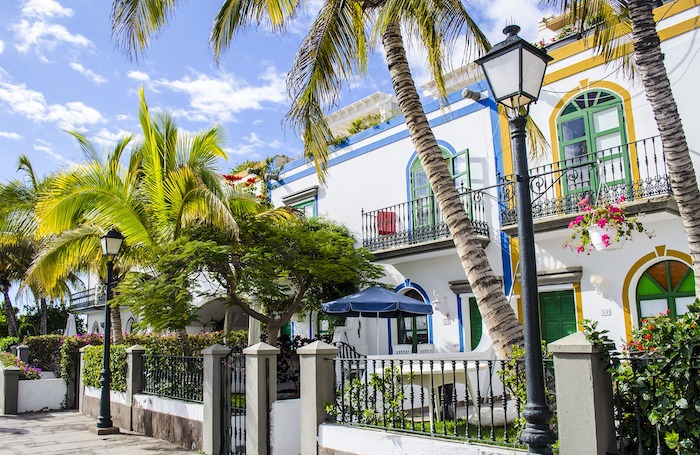
While low-growing palms are great for privacy and dramatic centerpieces, sometimes you need a tall palm tree for shade. Especially when you’re perched on the second-floor balcony, and the hot sun is burning.
Foxtail palms (Wodyetia bifurcata) are a great choice for extra shade. They can grow up to 25 feet and have a large, fluffy head of pinnate leaves growing up to 8 to 10 feet long.
The cocos or queen palm (Syagrus romanzoffianai) also is an excellent palm to grow near a balcony, deck, or patio for shade. This palm can reach heights up to 50 feet with a canopy spread of 20 to 25 feet.
Pro tip: When finding the right palm tree to provide shade near your home, consider speaking with a professional landscaper. A landscaper can help determine the safest distance between your home and the palm.
It’s not just a palm tree you’re working with, but also the sun’s path. You won’t get the shade you’re looking for if you plant a palm tree in a spot where it doesn’t block the sun at your most active outdoor hour. A professional can help determine where the palm will provide the best shade at the optimal time of day.
12. Frame the home or entryway
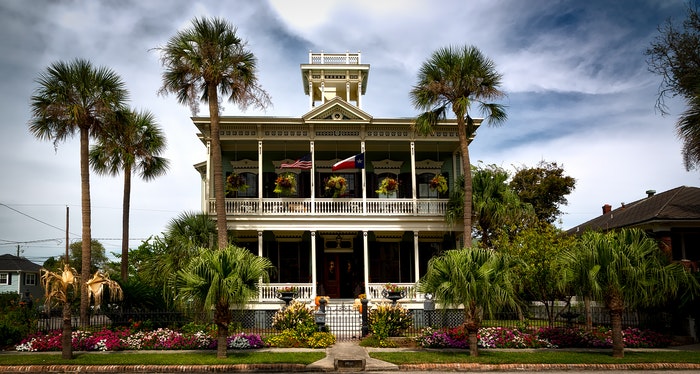
To frame your entryway in a dramatic way, any palm tree height will do. Short, sturdy, or tall –– several types of palms will make a striking entryway or frame.
Want your guests to feel they’re walking straight into paradise? Plant two palm trees framing the entrance to the pool, gate, home, or driveway. Your neighbors will marvel at your grand home with two parallel palm trees giving it a unified, sophisticated look.
13. Plan ahead for blooms
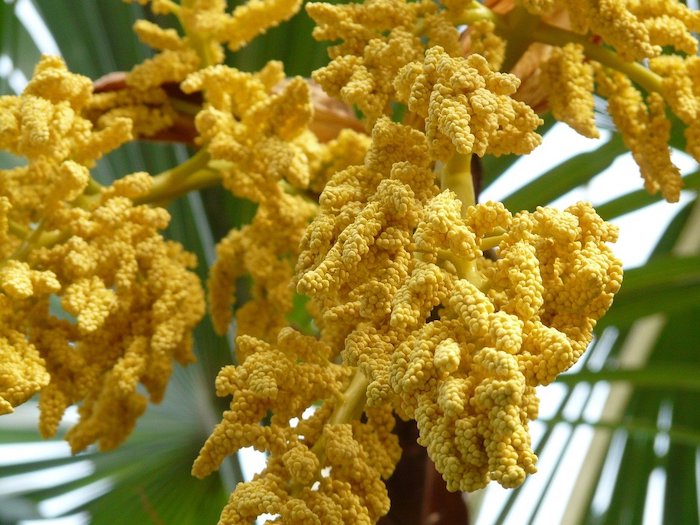
When landscaping with palm trees, there is more to consider than pinnate or palmate, tall or short. Many palms produce flowers and exotic fruits. Consider the color, texture, aesthetic, bloom time, and whether you wish to harvest these fruits. Fruit-bearing palm trees include:
- Coconut palm (Cocos nucifera)
- Date palm (Phoenix dactylifera)
- Pindo palm or jelly palm (Butia odorata)
14. Extend your container garden

Many palms make great container trees. A container palm can be a charming addition to your existing container garden, grown indoors, or stand-alone.
Growing a palm in a container also allows you to move it from place to place in the yard. If you no longer want it by the pool, move it closer to the deck.
The best container palms are either low growing or slow growing and are drought tolerant.
These are some of the palms that make excellent container plants:
- Mexican blue palm (Brahea armata)
- Dwarf palmetto (Sabal minor)
- Chinese windmill palm (Trachycarpus fortunei)
- Lady palm or bamboo palm (Rhapis excelsa)
15. Shoot for the moon

With majestic palm trees growing at heights above 50 feet, your landscape will leave an impression on anyone who strolls by.
Royal palm (Roystonea regia) reaches heights of 50 to 80 feet, and the coconut palm (Cocos nucifera) can grow to an impressive 100 feet.
When to Call a Landscaping Pro
Adding palm trees can do wonders for your yard. The possibilities are almost endless with these majestic monocots.
Call a landscaping professional near you for help with planting, maintenance, or design. A professional can determine the most attractive spots in need of a palm, and they also can help you choose the most flattering palm for your yard.
If maintenance is a concern, a landscaper can water, fertilize, trim, and preserve the health of your palm trees.
Added bonus: Hiring a professional also ensures you don’t have to lift a finger. After all, isn’t that what a palm tree paradise is all about?
Main Photo Credit: MarcTutorials / Pexels